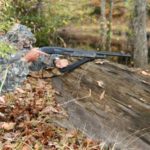
If your deer hunting is pretty much over for the season, don’t put your guns up. Grab a shotgun or .22 and hit the woods for some late-season squirrel hunting — when bushytails are in the peak of their winter breeding season.
The cold month of January marks the beginning of the end of our hunting season. The deer rut is over in many places, ducks have become harder to call in and hunters start thinking about fishing.
For some sportsmen, however, January is the beginning of a whole new season — hunting ground squirrels.
Squirrel hunting is often seen as a prelude to duck and deer season, something to do in October to scratch the itchy trigger finger. But the fact is that this month can be the best time to fill the freezer with some tasty tree rats.
One of the more pleasant aspects of this hunting is that you don’t have to get up before the crack of dawn because squirrels tend to be active later in the morning on cold winter days.
Also, the wind is not an issue because the squirrels are mostly on the ground searching for acorns. And they tend to stay still longer, presenting better shots than in the early season when they jump from limb to limb.
And, while the deer rut might be winding down over much of the state in January, the squirrel rut is in high gear.
That means the squirrels will often be bunched up, with several males chasing one female.
But John Hanks, a Louisiana Department of Wildlife and Fisheries biologist supervisor, said successful late-season hunts collate directly to October squirrel forays.
“Squirrels will be around the same trees in January as they were in October,” Hanks said. “It depends on which trees produced mast that year. If you see squirrels feeding in white oaks, willow oaks or nuttals during the early season, then look for them to be there in January.
“Squirrels will bury nuts for later use and will be looking for them in January. They don’t remember where they buried them all, so they will be on the ground finding them by smell. They are actually digging up a lot of acorns other squirrels buried.”
Hunters also can start planning next October’s squirrel hunts this month by looking for clusters of nests and well-worn holes that indicate den trees — both of which are much easier to spot in the dead of winter when the leaves have fallen.
Make mental notes of such things, and return there on opening morning next season.
But what’s the best approach to filling limits of bushytails this month?
Tactics for hunting winter ground squirrels are a little different from hunting in October. Whether you choose to use a .22 or shotgun, it’s important to wear full camouflage, especially to cover the face. Wearing a Ghillie suit helps break up your outline as you move through the woods after the undergrowth has become bare.
However, be sure to check the regulations concerning the wearing of hunter orange where you hunt. On WMAs, all hunters are required to wear orange during the open firearms season for deer.
The most-important difference in winter squirrel hunting is to watch the ground more than the trees because squirrels are spending most of their day on the ground searching for acorns and relatively little time in the canopy.
Move slowly and use a good pair of binoculars to scan ahead. Ground squirrels tend to remain nearly motionless for long periods of time as they dig up and eat acorns, and glassing the ground is a good way to detect them.
When scanning, pay special attention to fallen tree tops and logs because winter squirrels like to hang around them.
If you do bag a squirrel, don’t be in a hurry to pick it up. If there are others around, they will reveal themselves by either making a dash for a tree or barking at you.
And pay attention to sounds, listening for the peculiar grunting noise that rutting squirrels often make as they chase each other around a tree trunk.
Hanks believes the grunting is just the squirrels’ way of communicating with each other.
“It’s sort of a chuckle, and may be them just being playful,” he said.
So head to the woods this month, and you will be chuckling over a plate of fried squirrels and gravy.





